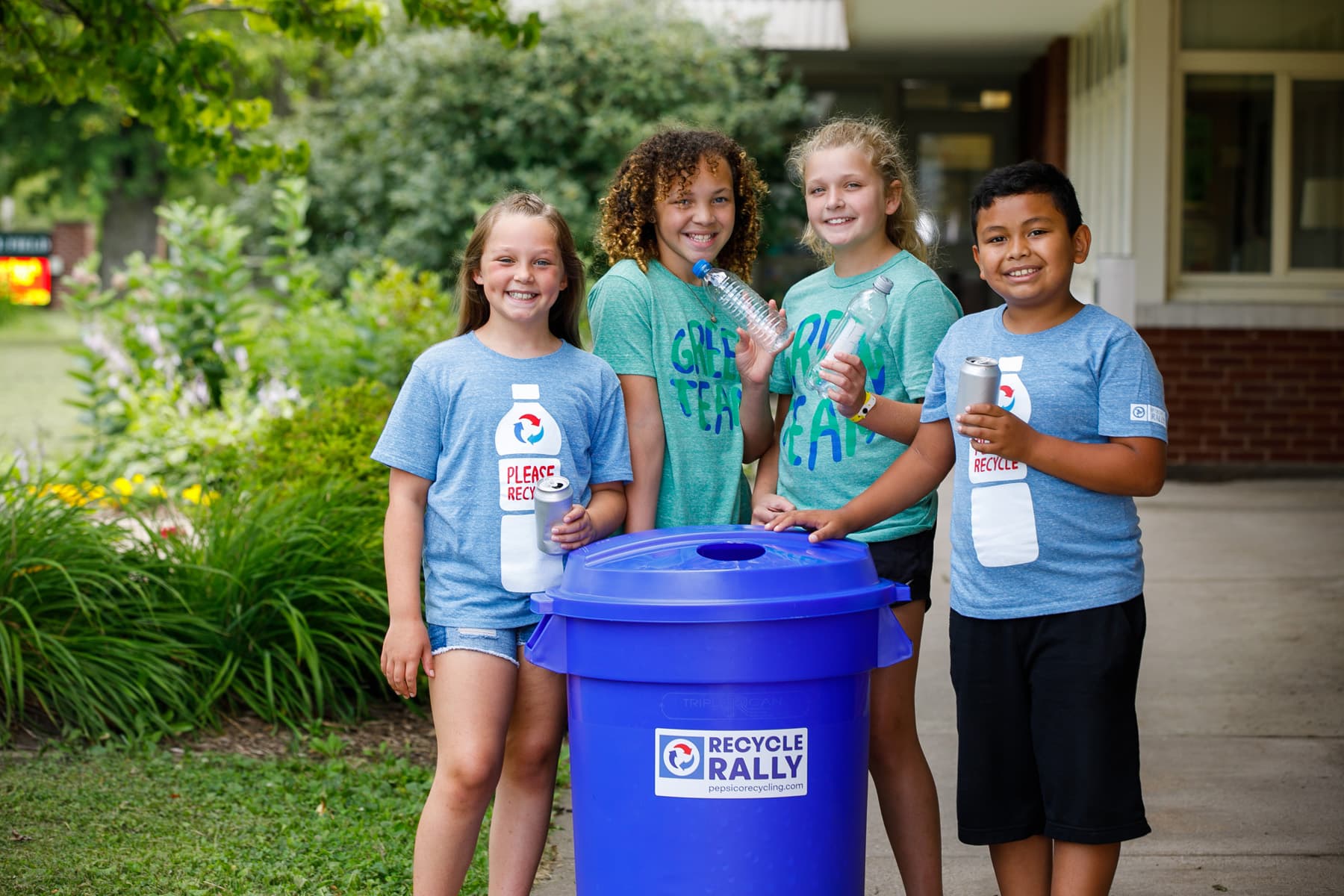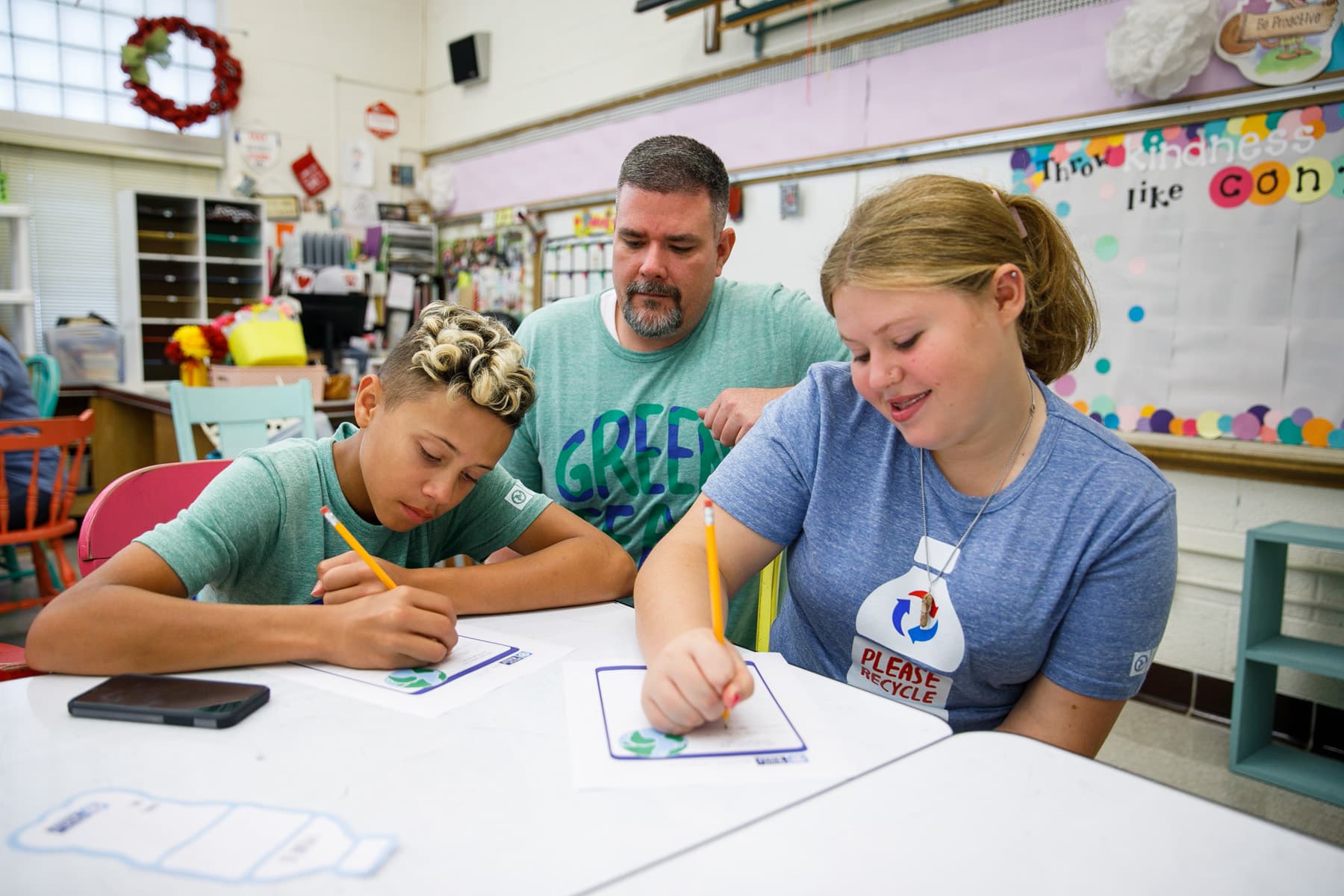What Is Environmental Sustainability?
It's all about balance.

In Illinois, one farmer’s cornfields remain green and lush while others struggle through a drought, thanks to the cover crops planted in the off-season. Across the world, in South Africa, kids play soccer on a pitch built with reclaimed chip packets. And in Colorado, a school’s green team found a way to recycle used socks! Every one of these is an example of environmental sustainability. But what does that really mean?
What Is Sustainability?
When something is sustainable, it is able to continue in the long run. Think of a marathon runner. Before they dive into a 26.2 mile race, they train and practice, learning the smartest ways to use their bodies. On race day, they must use their built-up stamina thoughtfully. If the runner puts all their energy into running the first mile, they’ll never make it all the way through. Instead, they sustain their energy by using it a bit at a time throughout the race. When the day’s race is over, marathon runners rest and recharge before gearing up to train and run again.
Environmental sustainability is about keeping the Earth going all the way through the marathon. We need to explore how we can use our resources responsibly, like a runner who trains to learn just how much energy they can use in every mile. It’s key that we know our limits, and conserve energy to use it only as needed. From time to time, we have to let the planet rest and recover—even marathon runners can’t keep running non-stop day and night. When possible, we must allow the Earth time to regenerate so we’ll be able to come back for more of those vital resources, time and time again.
Environmental sustainability is a never-ending cycle, one that requires us all to work together. We need to make personal, cultural, and systemic choices and changes, because the Earth belongs not only to all of us today, but also to everyone who follows us for generations to come. Individuals, businesses, communities, and governments all have important parts to play as we strive to keep our planet resilient and regenerative.
Managing Our Resources

The EPA explains it this way: “Sustainability is based on a simple principle: Everything that we need for our survival and well-being depends, either directly or indirectly, on our natural environment.” The Earth gives us everything we need to survive. But not everything it has to give will last forever.
For instance, for the last couple hundred years, humans have dug coal out of the ground and used it to heat their homes, cook their food, and provide power. But coal takes millions of years to form. So when we use up what’s there, there won’t be any more. The same goes for petroleum (oil) and other fossil fuels. On the other hand, renewable energy sources like solar and wind power are always available. That makes them more environmentally sustainable.
Some renewable resources require careful management, like trees. Some trees regrow fairly quickly, and planting and harvesting them properly makes them sustainable. Others, though, take hundreds of years (or more) to reach maturity. And clear-cutting entire forests not only destroys wildlife habitats, it can raise carbon dioxide levels in the atmosphere too quickly. So it’s vital that we manage even renewable resources in a sustainable way.
Reducing Our Waste

When it comes to environmental sustainability, sourcing Earth’s resources wisely is just one step. We also need to consider what happens to these resources after they’re used by humans.
Let’s look at plastic bags. They’re everywhere these days, and most of us tend to use them without much thought. But recycling plastic bags is tricky—in most places, you can’t just put them in your recycling bin. Many grocery stores offer places to return them for recycling, but lots of people don’t bother. If plastic isn’t recycled, it could end up in landfills or our oceans, harming the plants and animals that live there.
In fact, water is one of the biggest sustainability concerns. Life absolutely depends on clean water, but its overuse in some parts of the world creates scarcity. Also, microplastics have now been found in the farthest corners of the ocean, harming wildlife, from small birds to giant whales.
Even actions that seem good, like fertilizing crops so they grow better, can cause problems when fertilizer runoff pollutes rivers and groundwater. That’s why it’s so important to consider how our actions affect the planet at large. By reducing, reusing, and recycling, we can help safeguard our planet for future generations.
Slowing Climate Change
You’ve seen the news. Our planet’s overall temperature is rising faster than ever before, and human actions are a big contributing factor. Climate change is a complicated topic, but it’s inextricably linked with environmental sustainability.
Scientists are worried that if we don’t find ways to slow down climate change, our planet could be in real trouble. Rising sea levels could swamp coastal cities. A rise of just a few degrees in temperatures can affect how plants grow, altering farming practices and harming ecosystems. It’s up to every one of us to learn how humans are accelerating climate change and understand what we can do to stop it.
Reversing climate change will require everyone, in both the public and private sectors, to make environmentally sustainable changes. For example:
- Many countries have signed the Paris Agreement, a legally binding UN treaty to keep global warming within 2 degrees Celsius.
- Businesses are making goals to achieve net zero emissions and reduce greenhouse gas emissions.
- Local governments are doing their part to address climate change by preparing robust climate action plans.
Advocating for Systemic Change
Consider your last trip to the grocery store. How many of your purchases came wrapped in non-recyclable plastic or other materials? How much gas and oil do you think was used to fly and truck your produce in from other states or countries? Did you bring reusable bags, or wind up using even more plastic to tote your items home?
Many of the changes we need to make to be environmentally sustainable are systemic. They’re part of an overall larger problem, often one that’s cultural. A few hundred years ago, people didn’t expect bags to be provided for them at the market; they brought their own sacks or baskets. Food was rarely pre-packaged, and you could only buy produce that was local and in season.
In many parts of the world, that’s changed entirely. And that’s a problem, because that excess packaging isn’t just overburdening landfills and causing water pollution. Most manufacturing processes, like those used to make that packaging, produce carbon dioxide, which contributes to global warming. If we can cut down on single-use packaging, we can help reduce greenhouse gases, landfill waste, and pollution, all from one basic change.
Systemic change takes time and commitment. We need to stop burning fossil fuels like coal and oil by conserving electricity or taking traditional combustion engines off the roads. Farmers must adjust their use of pesticides and fertilizers to protect the environment, while still producing crops to feed the world. Consumers need to consider their purchases carefully, and possibly make fewer of them. These can be hard changes to make up front, but the long-term payoff is necessary for humanity’s continued existence on this planet.
Take Environmentally Sustainable Actions

We have the power to make a difference. Change starts with everyday sustainable choices, and doing the right thing for the planet comes with personal benefits, too! It can help spark creativity, engage you in rewarding local service opportunities, and may even contribute to a healthier lifestyle.
The biggest way you can make a difference is to vote with your dollars. Do your research, and support companies that have made a commitment to environmental sustainability. Buy a fuel-efficient vehicle, choose items without wasteful packaging, and shop local. Businesses may be more likely to make changes when they realize that their customers will take their money elsewhere if they don’t.
Here are more actions you can take on your journey to environmental sustainability.
- Make sustainable choices. Choose a reusable water bottle. Turn off lights and other electrical items when you’re not using them. Don’t waste water. There are so many ways you can help the environment in your own daily life.
- Try a zero-waste challenge. Skip plastic straws, fix something instead of replacing it, replace plastic bags with reusable ones—small choices add up!
- Lower your carbon footprint. Walk instead of drive, adjust your thermostat to save energy, try Meatless Mondays to eat less meat and dairy. Small changes to your routine are easy once you’re used to them.
- Spread the word. Speak up and share the facts! Urge your community and its leaders to create and support sustainable efforts like recycling and renewable energy.
- Start a recycling program at your school. Recycle Rally has all the tools you need to get going.
More Environmental Sustainability Resources
Want to learn more about this important topic? Here are some good options.
Sustainable Waste Curriculum
Recycle Rally is thrilled to introduce our sustainable waste curriculum, adaptable for grades 6-12 and created in partnership with EcoRise!
Environmental Protection Agency (EPA)
The EPA has lots of amazing resources for those who want to help the planet. Here are some that are perfect for schools and students.
- Climate Change Science
- Sustainable Marketplace
- Learning and Teaching About the Environment
- Healthy School Environments
Energy.gov
Find lots of useful info about clean energy, climate change, and more. Plus, the Department of Energy’s STEM Rising program is a terrific source for teachers, students, and the community.
PepsiCo Positive is a strategic end-to-end transformation with sustainability at the center of how the company will create growth and value by operating within planetary boundaries and inspiring positive change for the planet and people.
Take the What is Environmental Sustainability Kahoot! Quiz Now
Learn More

Recycle Rally
Recycle Rally is a free K-12 program that provides rewards and tools to help enhance recycling at your school!
Explore now
Additional Resources
Our comprehensive library of resources was designed to inspire the next generation of green leaders.
Explore now

